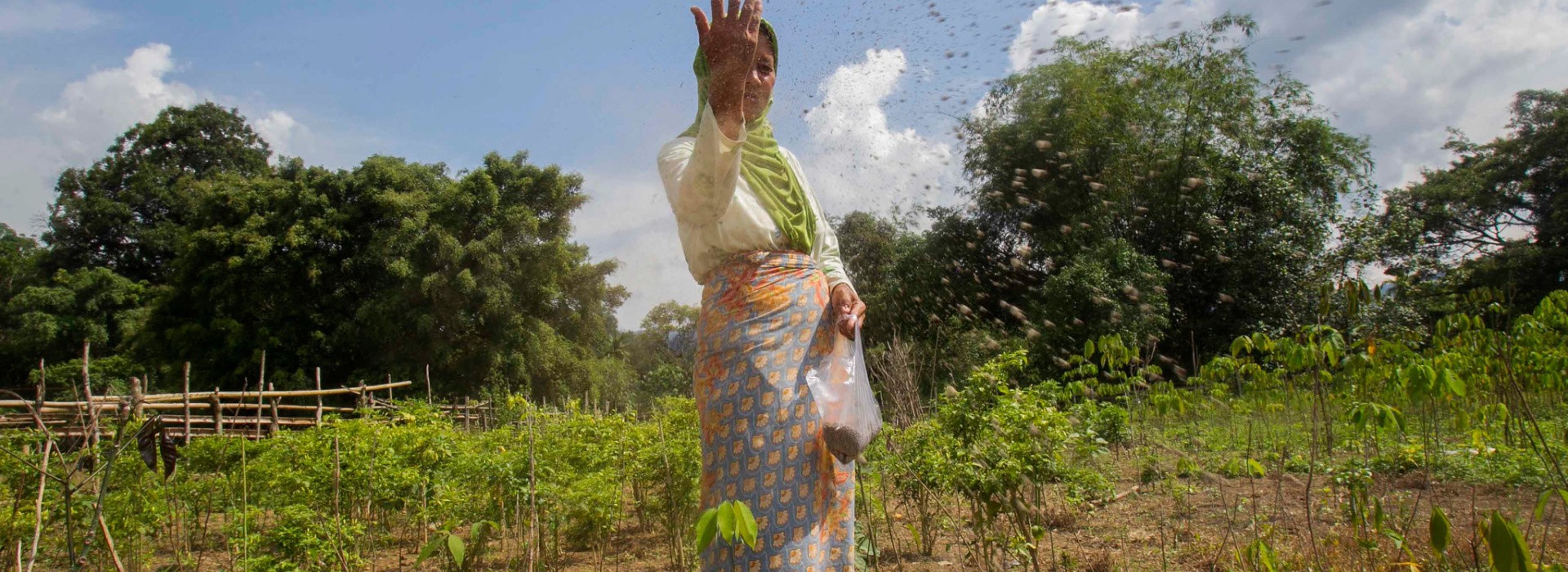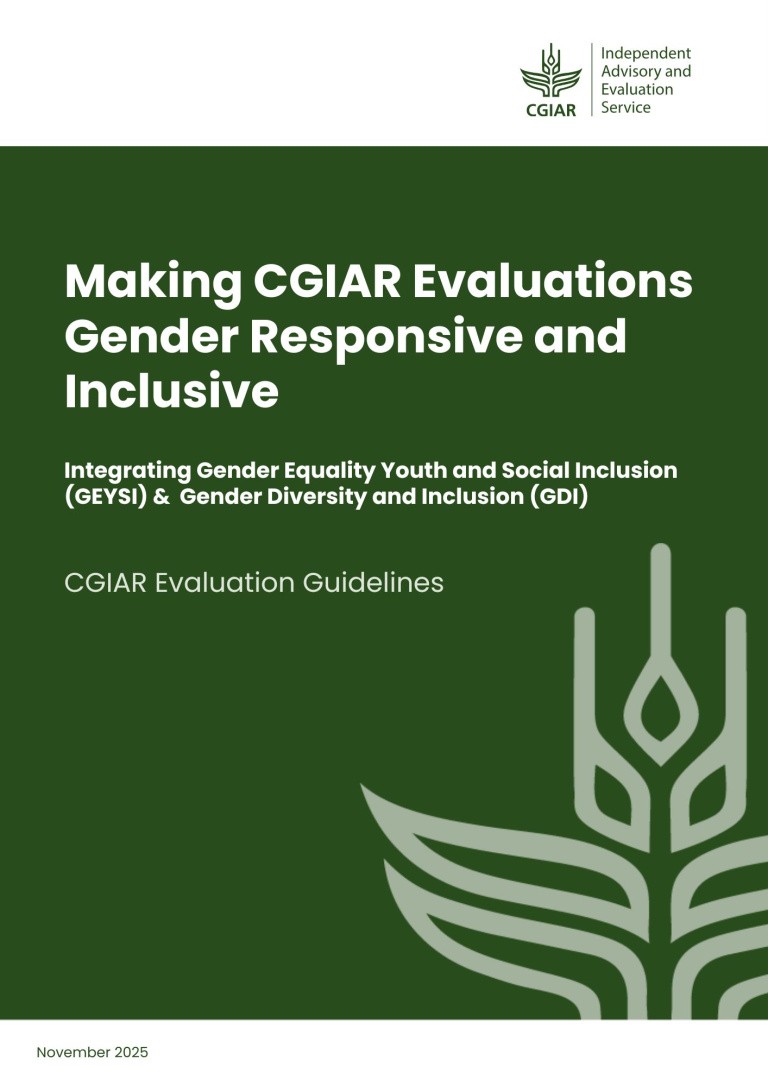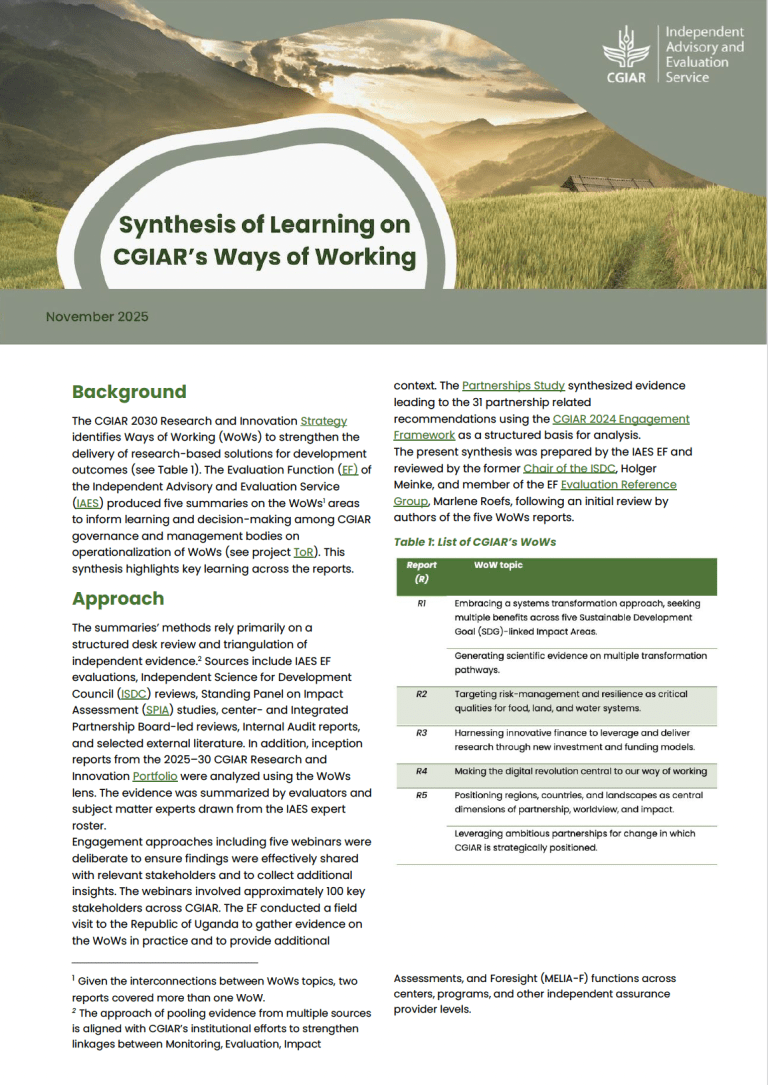Overview of the GENDER Platform and Evaluation
CGIAR’s "Generating Evidence and New Directions for Equitable Results" (GENDER) Platform aimed to guide and strengthen CGIAR research, ensuring its meaningful and long-lasting contribution to global goals for gender equality, while also creating opportunities for youth and social inclusion. The GENDER Platform was structured around three interlinking thematic modules: alliances, evidence, and methods.
The new GENDER Impact Platform has transitioned on expanding from its previous iteration as the GENDER Platform (2020-2022) and has been bolstered by gender research in previous CGIAR portfolios. The Platform engages with multiple diverse stakeholders within CGIAR and beyond, such as National Agricultural Research and Extension Systems (NARES), international organizations, academia, advanced research institutes, non-governmental organizations (NGOs), and civil society organizations. Through various distribution channels, representatives of all were invited to participate in this survey.
CGIAR’s Independent Advisory and Evaluation Service (IAES) commenced the evaluation of the GENDER Platform to carry out the following: assess the Platform’s progress from January 2020 to October 2022, document lessons and good operational practices, provide forward-looking recommendations for the newly transitioned Gender Impact Platform, and inform other CGIAR Impact Platforms.
Consistent with IAES's mandate, this independent external evaluation contributes toward institutional learning and provides evidence for steering and accountability to be delivered on CGIAR’s portfolio.
The evaluation Inception Report specifies the evaluation scope being focused on the GENDER Platform; the evaluation would also draw insights and cross-cutting linkages from previous evaluations of platforms (the CGIAR Excellence in Breeding and Big Data in Agriculture Platforms)-both of which also conducted online surveys with relevant stakeholders. The evaluation is guided by four evaluation theories-namely theory-based, utilization-focused, participatory, and feminist approaches-and utilizes mixed methods for its data inquiry. Qualitative and quantitative data, including from this survey, would be triangulatedto answer key evaluation questions. Watch the video from the June 2nd gLOCAL event on the approaches and methodology to the evaluation.
Online Survey Results-Snapshots
The evaluation team developed a semi-structured survey tool which was pre-tested by a small sample of Platform team members and people external to CGIAR. The survey questions inquired about respondent’s interaction with the Platform and its activities, as well as the Platform’s processes and results. The survey also asked module-specific questions and forward-looking questions to inform the new Impact Platform. The main target audience for the survey included the Platform’s listserv (about 216 members), internal groups as leads and deputies, and MELIA focal points of the initiative design teams, CGIAR’s MEL community of practice, and the platforms stakeholder list-in total around 671 people. The survey was also announced on the IAES site on 8 March 2023. Based on the total number of responses received (119), an estimated response rate is at a maximum of 18%.
Survey Results: Socio-Demographics
Out of the total 119 responses, a subset of 84 respondents provided more thorough demographic information. This subset represented individuals from 29 different home countries-71% of whom were CGIAR staff members, while the remainder represented stakeholders external to CGIAR, including funders, NGOs, NARES, the private sector, and other advanced research institutions.
Seven out of ten (71%) respondents were female; among all respondents, two in five (40%) were between the ages of 35-44 years old. As many as 67% were educated up to PhD doctorate level; and more specifically, 73% of respondents were scientists. The survey was overall geographically representative, with over half being from the global south (52%). Responses were received from 12 CGIAR Centers and across the five CGIAR Impact areas-half contributing to the Gender Equality action area (53%).[1]
Figure 1: Genders of respondents (n=84)

Figure 2: Region of respondents’ home country (n=84)

Figure 3: Respondents’ highest level of education (n=84)

Figure 4: Respondents’ categories (CGIAR staff): which impact area does your work mainly contribute to? (n= 58)

Survey Results: GENDER Platform’s Relevance and Achievements
To ensure relevance of CGIAR gender research, the Platform and its modules collaborate with internal and external stakeholders. Most survey respondents (65%) agreed or strongly agreed that the Platform supported the development of diverse methods in support of gender research and gendered outcomes in agricultural research for development (AR4D). Several respondents stated they had benefited from the “toolbox of methods and tools” that the Platform provides and that “embedding Women Empowerment in Agriculture Index (WEAI) work into the Platform” worked well.
Figure 6: Statement: The Platform supported the development of diverse methods in support of gender research and gendered outcomes in AR4D. Response (Likert)(n=77)

Several respondents reflected that gender networking, mentoring, capacity building, the involvement of multiple Centers and researchers across CGIAR and the “integration of GREAT- as a key National Agricultural Research Services (NARs) partner-into the Platform” were some of the aspects that worked well in the Platform.
Box 2: Responses on what is working well in the Platform
“Good research requires good data. The methods module grants helped to fill an unmet need among CGIAR gender researchers.”
“The Platform has emerged as a repository of evidence and knowledge on gender in agriculture, in terms of both research and practice.”
“The inclusion of researchers from various CGIAR Centers.”
“I feel that the staff at the platform were very knowledgeable and supportive of the partner organizations like ours. We felt our engagement to be valued by the CGIAR GENDER Platform.”
“Raising awareness related to gender equality and social inclusion.”
Half of the respondents (n=96) agreed or strongly agreed that the Platform supported the co-creation of effective gender alliances to position CGIAR as a thought leader for gender research in AR4D (check executive summary in Annex to the evaluation report). (See chart below).
Figure 7: Statement: The Platform has supported the co-creation of effective gender alliances to position CGIAR as a thought leader for gender research in AR4D. Response (Likert)(n=96)

Similarly, 41% of respondents agreed or strongly agreed that the Platform was successful at filling the gender evidence and research gaps which were not addressed fully at the CGIAR Center-level.
Figure 8: Statement: The Platform was successful at filling the gender evidence and research gaps which were not addressed fully at the CGIAR Center-level. Response (Likert)(n=94)

The survey results demonstrate the increasing importance of gender research within GIAR. Among CGIAR gender researchers, 84% (n= 50) agreed or strongly agreed that the demand for gender research is increasing in CGIAR Centers; while almost all CGIAR non-gender researchers (four in every five out of n=21) agreed or strongly agreed. Furthermore, there was a generally positive view of how the GENDER Platform contributed to enabling high-quality research on matters relating to gender: 82% of respondents agreed or strongly agreed that the GENDER Platform is well positioned to create opportunities in gender research (see below).
Figure 5: Responses to Likert Scales on the efficacy of the GENDER Platform (n=90)

The Platform is powered by gender researchers across CGIAR, including Centers and Initiatives (via Initiative focal points). The Platform collaborates with other scientists in CGIAR, bridging interdisciplinary/transdisciplinary synergies to integrate gender dimensions in AR4D. Non-gender specialists recognized that the demand for research on gender was encompassing-only 5% agreed that CGIAR Centers and Initiatives no longer need to include gender-related work in their activities because the GENDER Platform covers most of this work.
Box 1: Gender researchers regarding opportunities in gender research
“I receive more requests for support by other scientists to integrate gender in their work”. “There is growing appreciation for the importance of gender dimensions, even among non-gender researchers”.
“The Initiatives-given how many there are, and the fact that each should include some gender research-seem to have created demand for gender researchers.”
“There are few gender researchers within my center and the increasing call by donors to have a gendered lens in all our work has led to increased needs for gender experts and capacity building of non-gender scientists to integrate gender into our research work. Unfortunately, even with the demand, adequate funds are not allocated for gender work nor experts to meet this demand.”
Some gender researchers also corroborated that funder demands and “pressure” to work towards the sustainable development goals (SDGs) triggered a corresponding demand to collaborate with gender researchers and to integrate gender into their research. Of the marginal percentage of respondents who disagreed or strongly disagreed with the direction of the demand for gender research, some considered that most of the work has been “mainstreaming” and felt that it was not “gender-focused”. Furthermore, more than 20 respondents shared critical feedback about what was missing in the Platform. Approximate grouping of ideas provides useful insight for the Impact Platform moving forward (see below).
| Collaboration and communication |
|
| Management and leadership |
|
| The gender research and its place in the Platform |
|
Survey Results: Responding to New Demands and Integrating Gender Dimensions, Youth and Inclusion Considerations in Research
In October 2022, the GENDER Platform was relaunched as the CGIAR GENDER Impact Platform, which expands the Platform’s mandate beyond gender to include youth and social inclusion. Only half of the respondents (47%) reported having knowledge of the Impact Platform’s new mandate.
Figure 9: Statement: “I have good knowledge about the GENDER Impact Platform’s new mandate.” Response (Likert)(n=102)

Respondents have high expectations for the expanded Impact Platform. A large proportion (77%) of respondents (n=90) want the GENDER Impact Platform to create networking opportunities and help develop partnerships related to gender research and practice. Over half of the respondents (54%) would like for the Platform to provide insights into research developments around gender equality, youth, and social inclusion. Several others called for support in four thematic areas: helping to identify entry points to address gender in One CGIAR Action Areas and Initiatives (51%); providing resource materials on gender analysis and mainstreaming (50%); supporting the development of a gender theory of change for initiatives (49%); and provide resource materials to support gender integration into research.
The survey contained module-related questions for those respondents who had closely engaged or worked specifically with the Platform’s modules. Most respondents who had engaged with the evidence module (78% with n=27) agreed or strongly agreed that the Platform has increased the visibility of evidence generated by CGIAR gender research. Similarly, 81% of respondents who had engaged with the methods module (n=36) felt that the Platform has increased the visibility of methods and tools generated by CGIAR gender research to a large or very large extent. And 91% (n=23) of respondents who engaged via the alliances’ module agreed or strongly agreed that the module activities have strengthened capacities to improve the quality of research within the CGIAR.
Stay Tuned: The Evaluation Report
All the evidence collected during evaluation would be triangulated: full survey data will complement qualitative data; results will be provided in an annex to the main evaluation report.
As the GENDER Platform endeavors to integrate gender into agricultural research by generating evidence, fostering collaborations, and promoting gender equality, this evaluation would enable stakeholders to make informed decisions, allocate resources effectively, and identify strategies for enhancing the Platform's contributions to gender-responsive agricultural development.
Stay tuned for the final report and a Management Response in July 2023 on this page!
[1] Concerning socio-demographics, only 84 out of 119 respondents voluntarily provided data to support this inquiry.



